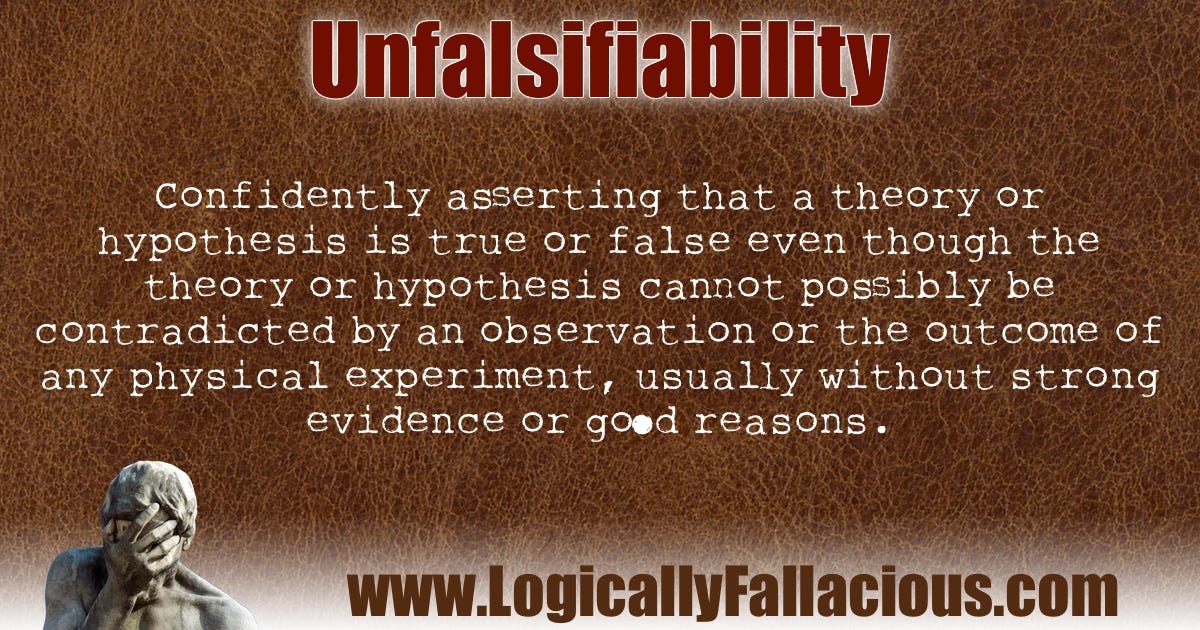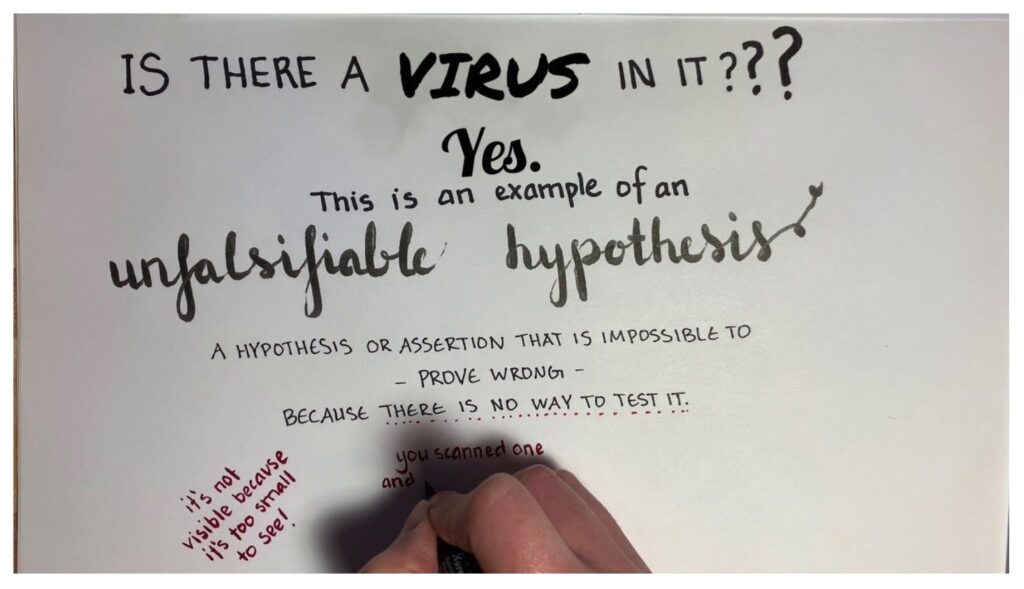Mike Stone
designating or of a statement, theory, etc. that is so formulated as to permit empirical testing and, therefore, can be shown to be false
Beyond adherence to the scientific method, a key factor in determining whether or not the evidence gathered during research is indeed scientific rather than pseudoscientific is a simple concept known as falsifiability. This idea was introduced by scientific philosopher Karl Popper in 1935 in his book The Logic of Scientific Discovery. Essentially, what falsifiability means is that, in order for a hypothesis or theory to be scientific, it must have the ability to be disproven. Someone should be able to conceivably design an experiment that could prove the hypothesis or theory wrong. If a hypothesis or theory is capable of being proven wrong and yet it is supported by experimental evidence of its truth, then it can be considered as a scientific hypothesis or theory.
Popper explained his reasoning for this criterion in his 1963 book Conjectures and Refutations. Falsification was an attempt to draw a line between science and pseudoscience. He was bothered by the ways in which observations could be easily fit to confirm whatever theory was believed by the eye of the beholder. In this way, it is easy to create a confirmation bias where one ignores contradictory information in order to claim that the vast majority of the observations fit within their own theoretical paradigm. Thus, Popper laid out some rules that could discern real scientific confirmations over those that are pseudoscientific. Confirmations should only be accepted if they are able to be refuted. If the hypothesis or theory stands tall in face of the experiments attempting to disprove it, this gives the researcher stronger conviction that their hypothesis and/or theory is correct. Popper wanted to ensure that those who believed in a certain hypothesis or theory could not reinterpret it in a way that it could escape refutation once it was proven to be false:
“The most characteristic element in this situation seemed to me the incessant stream of confirmations, of observations which “verified” the theories in question; and this point was constantly emphasize by their adherents. A Marxist could not open a newspaper without finding on every page confirming evidence for his interpretation of history; not only in the news, but also in its presentation — which revealed the class bias of the paper — and especially of course what the paper did not say. The Freudian analysts emphasized that their theories were constantly verified by their “clinical observations.” As for Adler, I was much impressed by a personal experience. Once, in 1919, I reported to him a case which to me did not seem particularly Adlerian, but which he found no difficulty in analyzing in terms of his theory of inferiority feelings, Although he had not even seen the child. Slightly shocked, I asked him how he could be so sure. “Because of my thousandfold experience,” he replied; whereupon I could not help saying: “And with this new case, I suppose, your experience has become thousand-and-one-fold.”
What I had in mind was that his previous observations may not have been much sounder than this new one; that each in its turn had been interpreted in the light of “previous experience,” and at the same time counted as additional confirmation. What, I asked myself, did it confirm? No more than that a case could be interpreted in the light of a theory. But this meant very little, I reflected, since every conceivable case could be interpreted in the light Adler’s theory, or equally of Freud’s. I may illustrate this by two very different examples of human behavior: that of a man who pushes a child into the water with the intention of drowning it; and that of a man who sacrifices his life in an attempt to save the child. Each of these two cases can be explained with equal ease in Freudian and Adlerian terms. According to Freud the first man suffered from repression (say, of some component of his Oedipus complex), while the second man had achieved sublimation. According to Adler the first man suffered from feelings of inferiority (producing perhaps the need to prove to himself that he dared to commit some crime), and so did the second man (whose need was to prove to himself that he dared to rescue the child). I could not think of any human behavior which could not be interpreted in terms of either theory. It was precisely this fact—that they always fitted, that they were always confirmed—which in the eyes of their admirers constituted the strongest argument in favor of these theories. It began to dawn on me that this apparent strength was in fact their weakness.”
“These considerations led me in the winter of 1919-20 to conclusions which I may now reformulate as follows.
1. It is easy to obtain confirmations, or verifications, for nearly every theory — if we look for confirmations.
2. Confirmations should count only if they are the result of risky predictions; that is to say, if, unenlightened by the theory in question, we should have expected an event which was incompatible with the theory — an event which would have refuted the theory.
3. Every “good” scientific theory is a prohibition: it forbids certain things to happen. The more a theory forbids, the better it is.
4. A theory which is not refutable by any conceivable event is non-scientific. Irrefutability is not a virtue of a theory (as people often think) but a vice.
5. Every genuine test of a theory is an attempt to falsify it, or to refute it. Testability is falsifiability; but there are degrees of testability: some theories are more testable, more exposed to refutation, than others; they take, as it were, greater risks.
6. Confirming evidence should not count except when it is the result of a genuine test of the theory; and this means that it can be presented as a serious but unsuccessful attempt to falsify the theory. (I now speak in such cases of “corroborating evidence.”)
7. Some genuinely testable theories, when found to be false, are still upheld by their admirers — for example by introducing ad hoc some auxiliary assumption, or by reinterpreting the theory ad hoc in such a way that it escapes refutation. Such a procedure is always possible, but it rescues the theory from refutation only at the price of destroying, or at least lowering, its scientific status. (I later described such a rescuing operation as a “conventionalist twist” or a “conventionalist stratagem.”)

To understand the concept of falsifiability better, let’s briefly examine what would be considered a falsifiable versus an unfalsifiable hypothesis. A falsifiable hypothesis could be stated as such:
If I water my plant every day, then it will grow.
This hypothesis can be easily tested to determine if watering the plant every day will, in fact, help it grow. It is falsifiable as it is possible that watering the plant every day will actually cause the plant not to grow as it may actually die from being oversaturated with too much water. If this latter scenario is observed, this would mean that the alternative hypothesis is proven to be false.
On the other hand, an extreme example of what would be an unfalsifiable hypothesis is blaming invisible unicorns for observing a ball falling to the ground as described here:
How We Edit Science Part 1: The Scientific Method
“An untestable hypothesis would be something like “the ball falls to the ground because mischievous invisible unicorns want it to”. If these unicorns are not detectable by any scientific instrument, then the hypothesis that they’re responsible for gravity is not scientific.
An unfalsifiable hypothesis is one where no amount of testing can prove it wrong. An example might be the psychic who claims the experiment to test their powers of ESP failed because the scientific instruments were interfering with their abilities.”
Of course, unicorns have never been proven to exist and we have no ability to actually observe, study, and detect them. While there may be hundreds or even thousands of indirect confirmatory evidence supporting this unicorn hypothesis, there is no ability to actually determine any truth in regard to the initial hypothesis as there is no ability to test it without unicorns existing. Thus, this is an unfalsifiable hypothesis.
It may already be evident based upon the unicorn analogy that “viruses” actually fit into this same unfalsifiable mold. As these entities have never been observed in nature and directly studied, there is no abilty to know how to detect and actually test for these invisible “pathogens.” The concept of a “virus” was created in order to explain symptoms of disease that could not be pinned on bacteria. However, as with bacteria, pseudoscientific rules were established in the face of contradictory experimental evidence in order to trick the masses into believing that the field was scientific when, in fact, it is anything but. Let’s explore some of these pseudoscientific concepts more in depth and see just how unfalsifiable virology, and by extension germ theory, truly is.




This gentleman reminds me a bit of our friend EJ Doyle who used to post here:
https://canadafreepress.com/article/new-music-video-asks-americans-to-wake-up-and-see-the-answers
Back up on Twitter…..1:14 …It’s that easy:
https://choiceclips.whatfinger.com/2023/04/19/this-video-got-whatfinger-banned-from-twitter-how-the-election-was-stolen-will-musk-keep-it-up-now/